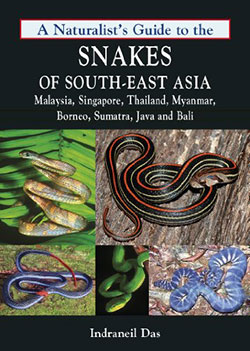Snakes of South-East Asia Malaysia, Singapore, Thailand, Myanmar, Borneo, Sumatra, Java and Bali
By Indraneil Das – (2012).
 160 pages; matt art paper, with 255 colour photographs & 2 maps.
160 pages; matt art paper, with 255 colour photographs & 2 maps.
Soft Cover. 18cm x 12.8cm.
ISBN 978-1-906780-70-8
John Beaufoy Publishing Limited UK.
Covering 239 of the 408 species of snake known to the region, this small handy pocket size book has been designed as a means for quick identification of snakes one may encounter in the field or during a trip to S.E. Asia. The selection of species is based on those that are more commonly encountered than others, not that you are likely to see a snake anyway unless you are actively looking for them in the forest or jungle.
The opening pages include a brief introduction on history of mythology and folklore, economic and conservation value, distribution, approximate numbers and briefly deals with the often unjustified persecution these poor creatures suffer from humans. Having said that however, there is a page dealing with the rare occasion where someone may suffer from a poisonous snake bite, which is generally the fault of an interfering provoking human.
Of all the 408 species of snake in the region there are probably only about 20 that could deliver a fatal bite to humans if provoked. Of those 20, the banded krait, banded coral snake and all of the vipers, even though possibly docile during the heat of the day, in the early evening these snakes are completely unpredictable and can and will bite without provocation. A female king cobra, if guarding a nest of eggs is an entity not be tangled with either night or day, as she will bite and even chase you if she feels you are threat to her clutch of coming new borne. However, the chance of encountering any of these entities is highly unlikely unless you are actively looking for them.
This book is very nicely illustrated with many high quality colour photographs of live specimens. Each species has its common and scientific names, places of habitat and distribution as well as a basic physical description. Among the many nice photos includes some rare species and photos of more common species not previously published. The book also contains a good glossary comparable with other bigger books on the subject.
Overall this a rather useful book and nicely illustrated and certainly worth buying if you have an interest in the snakes and reptiles of the region or a planning a nature trip to the region and wanting to know more about its snakes.
Rod Rice
Principal Reviewer
Nature & Travel Books
